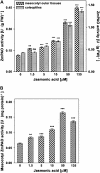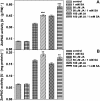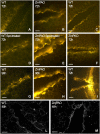Involvement of polyamine oxidase in wound healing
- PMID: 17993545
- PMCID: PMC2230557
- DOI: 10.1104/pp.107.108902
Involvement of polyamine oxidase in wound healing
Abstract
Hydrogen peroxide (H(2)O(2)) is involved in plant defense responses that follow mechanical damage, such as those that occur during herbivore or insect attacks, as well as pathogen attack. H(2)O(2) accumulation is induced during wound healing processes as well as by treatment with the wound signal jasmonic acid. Plant polyamine oxidases (PAOs) are H(2)O(2) producing enzymes supposedly involved in cell wall differentiation processes and defense responses. Maize (Zea mays) PAO (ZmPAO) is a developmentally regulated flavoprotein abundant in primary and secondary cell walls of several tissues. In this study, we investigated the effect of wounding on ZmPAO gene expression in the outer tissues of the maize mesocotyl and provide evidence that ZmPAO enzyme activity, protein, and mRNA levels increased in response to wounding as well as jasmonic acid treatment. Histochemically detected ZmPAO activity especially intensified in the epidermis and in the wound periderm, suggesting a tissue-specific involvement of ZmPAO in wound healing. The role played by ZmPAO-derived H(2)O(2) production in peroxidase-mediated wall stiffening events was further investigated by exploiting the in vivo use of N-prenylagmatine (G3), a selective and powerful ZmPAO inhibitor, representing a reliable diagnostic tool in discriminating ZmPAO-mediated H(2)O(2) production from that generated by peroxidase, oxalate oxidase, or by NADPH oxidase activity. Here, we demonstrate that G3 inhibits wound-induced H(2)O(2) production and strongly reduces lignin and suberin polyphenolic domain deposition along the wound, while it is ineffective in inhibiting the deposition of suberin aliphatic domain. Moreover, ZmPAO ectopic expression in the cell wall of transgenic tobacco (Nicotiana tabacum) plants strongly enhanced lignosuberization along the wound periderm, providing evidence for a causal relationship between PAO and peroxidase-mediated events during wound healing.
Figures












Similar articles
-
Deregulation of apoplastic polyamine oxidase affects development and salt response of tobacco plants.J Plant Physiol. 2017 Apr;211:1-12. doi: 10.1016/j.jplph.2016.12.012. Epub 2017 Jan 15. J Plant Physiol. 2017. PMID: 28135604
-
Polyamine oxidase, a hydrogen peroxide-producing enzyme, is up-regulated by light and down-regulated by auxin in the outer tissues of the maize mesocotyl.Plant Physiol. 2003 Feb;131(2):803-13. doi: 10.1104/pp.011379. Plant Physiol. 2003. PMID: 12586904 Free PMC article.
-
Underexpression of apoplastic polyamine oxidase improves thermotolerance in Nicotiana tabacum.J Plant Physiol. 2017 Nov;218:171-174. doi: 10.1016/j.jplph.2017.08.006. Epub 2017 Aug 31. J Plant Physiol. 2017. PMID: 28886452
-
Wounding in the plant tissue: the defense of a dangerous passage.Front Plant Sci. 2014 Sep 16;5:470. doi: 10.3389/fpls.2014.00470. eCollection 2014. Front Plant Sci. 2014. PMID: 25278948 Free PMC article. Review.
-
Breaking Bad News: Dynamic Molecular Mechanisms of Wound Response in Plants.Front Plant Sci. 2020 Dec 8;11:610445. doi: 10.3389/fpls.2020.610445. eCollection 2020. Front Plant Sci. 2020. PMID: 33363562 Free PMC article. Review.
Cited by
-
Germin-like protein 2 gene promoter from rice is responsive to fungal pathogens in transgenic potato plants.Funct Integr Genomics. 2016 Jan;16(1):19-27. doi: 10.1007/s10142-015-0463-y. Epub 2015 Aug 16. Funct Integr Genomics. 2016. PMID: 26277722
-
Nitric oxide induced by polyamines involves antioxidant systems against chilling stress in tomato (Lycopersicon esculentum Mill.) seedling.J Zhejiang Univ Sci B. 2016 Dec.;17(12):916-930. doi: 10.1631/jzus.B1600102. J Zhejiang Univ Sci B. 2016. PMID: 27921397 Free PMC article.
-
The Apoplastic Copper AMINE OXIDASE1 Mediates Jasmonic Acid-Induced Protoxylem Differentiation in Arabidopsis Roots.Plant Physiol. 2015 Jun;168(2):690-707. doi: 10.1104/pp.15.00121. Epub 2015 Apr 16. Plant Physiol. 2015. PMID: 25883242 Free PMC article.
-
Lignin: characterization of a multifaceted crop component.ScientificWorldJournal. 2013 Nov 14;2013:436517. doi: 10.1155/2013/436517. ScientificWorldJournal. 2013. PMID: 24348159 Free PMC article. Review.
-
The Copper Amine Oxidase AtCuAOδ Participates in Abscisic Acid-Induced Stomatal Closure in Arabidopsis.Plants (Basel). 2019 Jun 20;8(6):183. doi: 10.3390/plants8060183. Plants (Basel). 2019. PMID: 31226798 Free PMC article.
References
-
- Alcázar R, Marco F, Cuevas JC, Patron M, Ferrando A, Carrasco P, Tiburcio AF, Altabella T (2006) Involvement of polyamines in plant response to abiotic stress. Biotechnol Lett 28 1867–1876 - PubMed
-
- Apel K, Hirt H (2004) Reactive oxygen species: metabolism, oxidative stress and signal transduction. Annu Rev Plant Biol 55 373–399 - PubMed
-
- Artiss JD, Entwistle WM (1981) The application of a sensitive uricase-peroxidase couple reaction to a centrifugal fast analyser for the determination of uric acid. Clin Chim Acta 116 301–309 - PubMed
-
- Augeri M, Angelini R, Federico R (1990) Sub-cellular localization and tissue distribution of polyamine oxidase in maize (Zea mays L.) seedlings. J Plant Physiol 136 690–695
Publication types
MeSH terms
Substances
LinkOut - more resources
Full Text Sources

